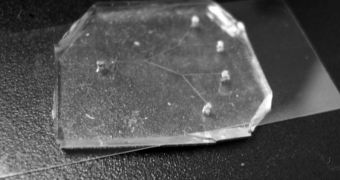Given the large number of women nowadays that get breast cancer, developing methods for detecting the diseases early on, and also for treating it, is a major public health priority. As part of these efforts, experts at Purdue University announce the development of a new research method.
The device the team produced is a tiny, slide-sized model of the tissue in a human breast, and is dubbed a “breast on-a-chip.” With it, experts hope to be able to test out several nanotechnology- and biotechnology-based approaches to detecting and treating breast cancer.
What the research instrument does is mimic the branching mammary duct system, which is an area of the human breast were most cancer begin and develop while in their earliest stages. The disease then goes on to spread throughout the breast.
Using the new “engineered organ,” investigators will be able to test out nanoparticles and other drug options, and see whether they detect tumor cells within the duct system or not.
The research group was led by Purdue School of Veterinary Medicine associate professor of basic medical sciences Sophie Lelièvre and colleague James Leary, the SVM Professor of Nanomedicine.
Leary is also a professor of basic medical sciences in the SVM, and a professor of biomedical engineering at the university's Weldon School of Biomedical Engineering.
“Breast cancer is the most common cancer in women in most countries, and in the US alone nearly 40,000 women lost their lives to it this past year,” Lelièvre explains.
“We've known that the best way to detect this cancer early and treat it effectively would be to get inside the mammary ducts to evaluate and treat the cells directly, and this is the first step in that direction,” she adds.
The expert also holds appointments as the associate director of discovery groups in the Purdue Center for Cancer Research, and as a leader of the international breast cancer and nutrition project in the Oncological Sciences Center at the university.
She believes that nanotechnology holds the key to detecting and treating breast cancer. Nanoparticles can be used to transport contrast agents inside the breasts, in order to improve mammography, and also to carry fluorescent markers to guide surgeons or anticancer agents to treat the tumors.
“Nanoparticles can be designed to latch on to cancer cells and illuminate them, decreasing the size of a tumor that can be detected through mammography from 5 millimeters to 2 millimeters, which translates into finding the cancer 10 times earlier in its evolution,” Leary explains.
“There also is great potential for nanoparticles to deliver anticancer agents directly to the cancer cells, eliminating the need for standard chemotherapy that circulates through the entire body causing harmful side effect,” she concludes.
Details of the investigation appear in the current issue of the esteemed journal Integrative Biology. The work was funded by the US Department of Defense (DOD).

 14 DAY TRIAL //
14 DAY TRIAL //